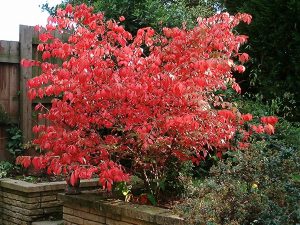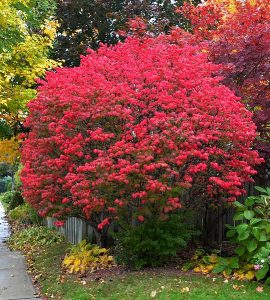
Summary
Burning bush, a shrub commonly planted for decorative purposes, is a destructive plant that is currently damaging our local forests. It can completely overtake a natural area, replacing large amounts of native vegetation and reducing biodiversity. However through manual removal and planting of alternative species, preventing further spread of burning bush into Crandall Park is possible.
The Threat of Burning Bush
Although beautiful, the popular decorative plant ‘winged burning bush’ is extremely hazardous to our local forests. Invasive to the United States, this plant was brought here from northeast Asia during the 1860’s for use as an ornamental bush. Currently, it can be found across the United States from New England to northern Florida, as well as in the state of Illinois. Due to its bright red autumn leaves and high fruit production, many people still use burning bush today as an ornamental plant, but there is one problem: burning bush damages surrounding woodlands.

Burning bush poses a threat to a variety of natural communities ranging from mountainous forests to coastal shrublands. And perhaps the most concerning issue is that it creates extremely dense thickets and complex root systems, crowding out large amounts of native forest vegetation. This process causes burning bush to overtake the forest, reducing the plant diversity within the area.
How it’s Spread
The burning bush plant is transported by animals that eat berries from the bush. Inside of these berries are small seeds; when an animal, like a bird, eats these berries it then carries the seeds with it to a new location. Eventually, the bird will defecate, releasing undigested burning bush seeds into the soil and allowing for new plants to grow.
A Relentless Species
Birds and small mammals are the main way in which burning bush can spread from the hedges lining your yard all the way into the forest, but there are also other qualities of the species that increase its chance of survival once it has spread, such as:
- Seed Production – Burning bush produces an extremely large amount of seeds. This high level of seeds cause burning bush populations to spread very quickly.
- Self-Fertilization – An individual burning bush plant can contain both male and female reproductive structures. This means that the plant can self-fertilize, and create a whole colony of offspring by itself.
- Vegetative Reproduction (Sprouting) – When a burning bush stem is cut or broken, the plant will grow even more new stems to replace the broken one. Since more stems are produced after cutting, the possibility for reproduction and spreading of the plant is also increased.
- Predator Avoidance – There are essentially no known natural predators that feed on burning bush. With no animals around to eat it, the plant can continue to grow and reproduce without any threat of predation.

Preventative Measures
After hearing all of this news, the problem of burning bush invasions may sound impossible to defeat, yet there are many steps that can be taken to help combat the issue. A new study shows that a type of burning bush has been developed that actually produces fewer seeds. This plant looks exactly the same as the ornamental type of burning bush that we have come to love, but fewer seeds means a reduced chance of it spreading deep into the forest. This new type of burning bush is known as the “Rudy Haag” variety, and produces and average of 12 seeds per plant, compared to an average of 1238 seeds per plant for the more common and currently used “Compactus” variety of burning bush. Other mechanisms for the control of already present burning bush populations include hand removal or herbicide application, a process where a chemical substance utilized in order to kill an individual plant. Burning bush has also recently been banned in Massachusetts, New Hampshire, and Long Island, NY.

How You Can Help
Here in Crandall Park, many burning bush plants are already present. You can identify them by looking for their bright red leaves during the fall, but a more distinct feature to keep an eye out for is their angular, winged branches. To prevent more burning bush from making its way into the park, we suggest that you avoid planting this species in your yard or workplace. Instead, consider planting one of the non-invasive species listed below:
For persistent berries to attract wildlife:
- Red Chokeberry (Aronia arbutifolia) – also has bright fall foliage
- Winterberry (Ilex verticillata)
- Highbush Cranberry (Viburnum trilobum)
For fall foliage/ornamental purposes:
- Silky Dogwood (Cornus amomum)
- Red Twig Dogwood (Cornus sericea)
- Highbush Blueberry (Vaccinium corymbosum)
References
Connecticut Invasive Plant Working Group. (n.d.). Invasive Plant Information Sheet: Winged Euonymus or Burning Bush. Retrieved March 31, 2017, from http://www.hort.uconn.edu/cipwg/pdfs/burning_bush.pdf
Knight, T. M., Havens, K., & Vitt, P. (2011). Will the use of less fecund cultivars reduce the invasiveness of perennial plants?. BioScience, 61(10), 816-822.
Lubell, J. D. (2013). Evaluating landscape performance of six native shrubs as alternatives to invasive exotics. HortTechnology, 23(1), 119-125.
Swearingen, J., Bargeron C. (2016). Invasive Plant Atlas of the United States. University of Georgia Center for Invasive Species and Ecosystem Health. http://www.invasiveplantatlas.org/
Wenning, B. (2012, April 13). Winged Euonymus: An Exotic Invasive Plant Fact Sheet – Ecological Landscape Alliance. Retrieved March 31, 2017, from http://www.ecolandscaping.org/04/invasive-plants/winged-euonymus-an-exotic-invasive-plant-fact-sheet/
Winged Burning Bush (Euonymus alatus). (2010, November 11). Retrieved March 31, 2017, from https://www.nps.gov/plants/alien/pubs/midatlantic/eual.htm
Image Credits
Ornamental burning bush: “Euonymus alatus” by Chris Barton is licensed under CC BY-SA 3.0
Berries of burning bush: “Euonymus alatus – R2709” by Jean-Pol GRANDMONT is licensed under CC-BY-3.0
Winged branches of burning bush: “Euonymus alatus OBG 09-07-16 02” by El Grafo is licensed under CC BY-SA 3.0
Burning bush in bloom: “Euonymus alatus Toronto” by Mykola Swarnyk is licensed under CC BY-SA 3.0